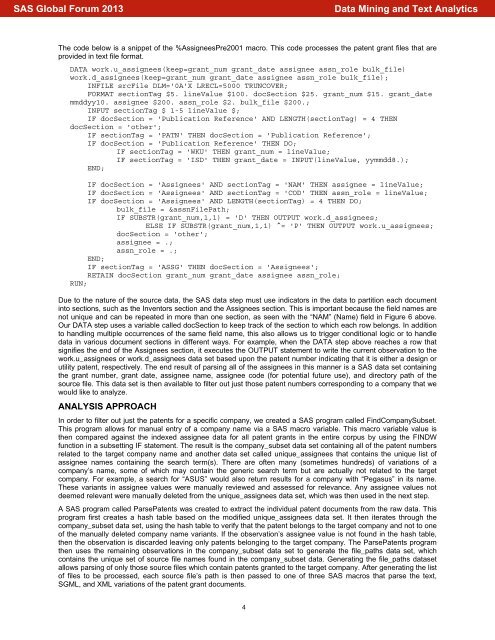Paper 101-2013 - SAS
Paper 101-2013 - SAS
Paper 101-2013 - SAS
You also want an ePaper? Increase the reach of your titles
YUMPU automatically turns print PDFs into web optimized ePapers that Google loves.
<strong>SAS</strong> Global Forum <strong>2013</strong><br />
Data Mining and Text Analytics<br />
The code below is a snippet of the %AssigneesPre2001 macro. This code processes the patent grant files that are<br />
provided in text file format.<br />
DATA work.u_assignees(keep=grant_num grant_date assignee assn_role bulk_file)<br />
work.d_assignees(keep=grant_num grant_date assignee assn_role bulk_file);<br />
INFILE srcFile DLM='0A'X LRECL=5000 TRUNCOVER;<br />
FORMAT sectionTag $5. lineValue $100. docSection $25. grant_num $15. grant_date<br />
mmddyy10. assignee $200. assn_role $2. bulk_file $200.;<br />
INPUT sectionTag $ 1-5 lineValue $;<br />
IF docSection = 'Publication Reference' AND LENGTH(sectionTag) = 4 THEN<br />
docSection = 'other';<br />
IF sectionTag = 'PATN' THEN docSection = 'Publication Reference';<br />
IF docSection = 'Publication Reference' THEN DO;<br />
IF sectionTag = 'WKU' THEN grant_num = lineValue;<br />
IF sectionTag = 'ISD' THEN grant_date = INPUT(lineValue, yymmdd8.);<br />
END;<br />
IF docSection = 'Assignees' AND sectionTag = 'NAM' THEN assignee = lineValue;<br />
IF docSection = 'Assignees' AND sectionTag = 'COD' THEN assn_role = lineValue;<br />
IF docSection = 'Assignees' AND LENGTH(sectionTag) = 4 THEN DO;<br />
bulk_file = &assnFilePath;<br />
IF SUBSTR(grant_num,1,1) = 'D' THEN OUTPUT work.d_assignees;<br />
ELSE IF SUBSTR(grant_num,1,1) ^= 'P' THEN OUTPUT work.u_assignees;<br />
docSection = 'other';<br />
assignee = .;<br />
assn_role = .;<br />
END;<br />
IF sectionTag = 'ASSG' THEN docSection = 'Assignees';<br />
RETAIN docSection grant_num grant_date assignee assn_role;<br />
RUN;<br />
Due to the nature of the source data, the <strong>SAS</strong> data step must use indicators in the data to partition each document<br />
into sections, such as the Inventors section and the Assignees section. This is important because the field names are<br />
not unique and can be repeated in more than one section, as seen with the “NAM” (Name) field in Figure 6 above.<br />
Our DATA step uses a variable called docSection to keep track of the section to which each row belongs. In addition<br />
to handling multiple occurrences of the same field name, this also allows us to trigger conditional logic or to handle<br />
data in various document sections in different ways. For example, when the DATA step above reaches a row that<br />
signifies the end of the Assignees section, it executes the OUTPUT statement to write the current observation to the<br />
work.u_assignees or work.d_assignees data set based upon the patent number indicating that it is either a design or<br />
utility patent, respectively. The end result of parsing all of the assignees in this manner is a <strong>SAS</strong> data set containing<br />
the grant number, grant date, assignee name, assignee code (for potential future use), and directory path of the<br />
source file. This data set is then available to filter out just those patent numbers corresponding to a company that we<br />
would like to analyze.<br />
ANALYSIS APPROACH<br />
In order to filter out just the patents for a specific company, we created a <strong>SAS</strong> program called FindCompanySubset.<br />
This program allows for manual entry of a company name via a <strong>SAS</strong> macro variable. This macro variable value is<br />
then compared against the indexed assignee data for all patent grants in the entire corpus by using the FINDW<br />
function in a subsetting IF statement. The result is the company_subset data set containing all of the patent numbers<br />
related to the target company name and another data set called unique_assignees that contains the unique list of<br />
assignee names containing the search term(s). There are often many (sometimes hundreds) of variations of a<br />
company’s name, some of which may contain the generic search term but are actually not related to the target<br />
company. For example, a search for “ASUS” would also return results for a company with “Pegasus” in its name.<br />
These variants in assignee values were manually reviewed and assessed for relevance. Any assignee values not<br />
deemed relevant were manually deleted from the unique_assignees data set, which was then used in the next step.<br />
A <strong>SAS</strong> program called ParsePatents was created to extract the individual patent documents from the raw data. This<br />
program first creates a hash table based on the modified unique_assignees data set. It then iterates through the<br />
company_subset data set, using the hash table to verify that the patent belongs to the target company and not to one<br />
of the manually deleted company name variants. If the observation’s assignee value is not found in the hash table,<br />
then the observation is discarded leaving only patents belonging to the target company. The ParsePatents program<br />
then uses the remaining observations in the company_subset data set to generate the file_paths data set, which<br />
contains the unique set of source file names found in the company_subset data. Generating the file_paths dataset<br />
allows parsing of only those source files which contain patents granted to the target company. After generating the list<br />
of files to be processed, each source file’s path is then passed to one of three <strong>SAS</strong> macros that parse the text,<br />
SGML, and XML variations of the patent grant documents.<br />
4
















